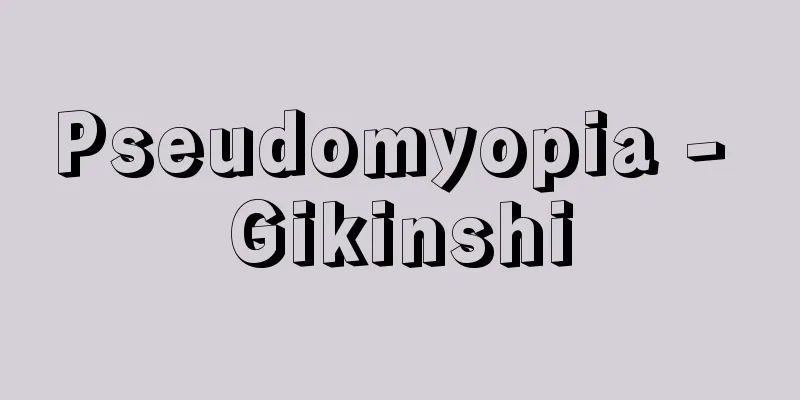New Kokin Wakashu - Shinkokin Wakashu

|
The eighth imperially commissioned anthology of waka poetry. 20 volumes. Published in the early Kamakura period. It was compiled by order of Emperor Gotoba. The editors were Minamoto no Michitomo, Fujiwara no Ariie, Fujiwara no Teika, Fujiwara no Ietaka, Fujiwara no Masatsune, and Jakuren. Unlike previous imperially commissioned anthologies, the Emperor himself participated in the selection process, and the preface and notes were written from his perspective, making this the first anthology in the "imperial selection style." [Goto Jiro] EstablishedThe Imperially Commissioned Twenty-One Generation Collection had the most complex and lengthy process of creation, and is usually thought of as being divided into four periods. (1) The first period of selection of poems In July 1201 (Kennin 1), following the example of "Gosenshu", the Wakadokoro (Poetry Office) was established and Yoryudo (members of the Wakadokoro) were appointed. On November 3 of the same year, six of the members were appointed as selectors and ordered to select the anthology. From then on, they were engaged in selecting poems until around April 20, 1203, when the selectors submitted the selected poems. Jakuren stopped midway and did not submit the work. (2) The second period of the Imperial Appreciation Period: This was a period in which the Imperial Court gave its approval to the poems submitted by the selectors up to three times to select and select them. (3) The third period, the "Burui" period: In July 1204 (the first year of the Genkyu era), the order for the "Burui" (allocation to each section and arrangement in each section) was given, and the work began. This period continued until the "Kyoen" banquet (a banquet held after the "Kyo" (the completion of the anthology) work) on March 26 of the following year, 1205. (4) The fourth period of the Kiritsugu period can be divided into the capital and Oki. The period in the capital covers the period after the banquet, when the Kiritsugu (kiridashi, kiriiri, tsuginashi) took place, and the period when the Kiritsugu came to an end with the progress of the plans for the Jōkyū War (1221), and when Minamoto Ienaga, the head of the Wakadokoro, copied it on December 26, 1216 (Kenpō 4). The period in Oki covers the period after 19 years on the island, when the Emperor turned his attention once again to the Shin Kokinshū and composed about 400 poems (this period is different in nature from the period in the capital, as it only involved the Kiritsugu). In this way, the collection has a long history of compilation spanning more than thirty years. Accordingly, the extant manuscripts have been divided into four categories. (1) The first type, the Kyoshien version, is a version written during the Kyoshien banquet. Its contents are quite different from the extant text due to subsequent cuttings and splicing. (2) Second Category: Texts from the Kiritsugu Period Most of the extant texts belong to a lineage that was created by copying the text from the Kiritsugu period, and it is believed that the form of the extant text was roughly finalized around 1209 (Shogen 3). However, since they were copied at various stages of the Kiritsugu period, there are differences regarding the Kiritsugu poems. (3) Type 3 Ienaga edition: This is the final edition of the text that put an end to the sekitsugi tradition in the capital, and was transcribed by Minamoto no Ienaga on December 26, 1216. It does not contain any kiridashi-uta poems, but has annotations written by Ienaga in both mana and kana. (4) Type 4 Oki edition: A book of about 400 poems cut out in Oki, with a new preface, Oki Sho. Furthermore, some of the "Shin Kokinshu" are collected by twenty-one generations, some are collected by multiple compilers, and some have so-called "compilation notes" that indicate which compiler selected which poems. There are differences in the type and position of the compiler's name symbols, and whether or not all of the compiler's names are included. However, poems without notes are thought to be cut-in poems by the retired emperor (or Fujiwara no Yoshitsune) after the selection was submitted to the Imperial Court. [Goto Jiro] ContentsThere are about 2000 poems. The preface in kana was written by Fujiwara no Yoshitsune, and the preface in mana was written by Fujiwara no Chikatsune (however, both were written from the perspective of Emperor Gotoba). It is divided into sections on spring, summer, autumn, winter, congratulations, sorrow, separation, journey, love 1-5, miscellaneous upper, middle and lower, Shinto, and Buddhism. It is also characterized by a concentration of eight eras, and the number of autumn poems is significantly higher than that of spring poems. Also, after "Senzaishuu" (Shinshoku Kokinshu), the Shinto and Buddhism sections are arranged consecutively, although the order may differ, but "Shin Kokinshu" is the only one in which the final volume 20 is the Buddhism section, and it is even said that the misfortune of the later Jokyu period was due to this arrangement. The composers are broadly divided into the Shui group of poets and the Senzai group of poets (according to Kazamaki Keijiro), and through the skillful combination of alternating groups of poems and groups of poets, and the beautiful arrangement within each group of poems, a poetic world is developed that is created not only by the beauty of each poem but also by the beauty of the arrangement. In terms of numbers, poets from the period when the anthologies were compiled or a little earlier are highly valued, such as Saigyo (94), Jien (92), Yoshitsune (79), Shunzei (72), Princess Shokushi (49), Teika (46), Ietaka (43), Jakuren (35), Emperor Gotoba (33), Lady Shunzei (29), Miyabi (22), Arie (19), and Michitsugu (17). Poets from earlier periods include Tsurayuki (32), Izumi Shikibu (25), and Hitomaro (23). [Goto Jiro] Singing StyleThese are known as the three great styles of poetry in the Manyo, Kokin, and Shin Kokin, and are notable for their lingering and alluring style, as seen in poems such as "A spring night's dream, my pillow smells like flowers on my sleeves as the wind blows through me" (Shunsei's daughter) and "In a spring night's dream, the floating bridge breaks and the sky of horizontal clouds parts into the mountains" (Teika).In terms of rhetoric, there are two types of style: noun-ending (the fifth line ends with a noun and the predicate comes before it, the "inversion method," and the "omission method," in which the predicate is omitted and needs to be added), odd-numbered line cutting (the first line cutting, the third line cutting, or the first line cutting and the third line cutting are usually referred to, but the third line cutting is particularly noteworthy in relation to renga), honka-dori (composing a new poem using the spirit and words of an old poem), kakekotoba (kakekotoba), and engo (related words), and they are used freely to create an aesthetic world in the Shin Kokin style. The Kokinshu came on the scene after the heyday of Chinese literature, the Imperially Commissioned Six National Histories ended with Emperor Koko, who preceded Emperor Uda, the dispatch of envoys to Tang China was abolished at the suggestion of Sugawara Michizane, and the era name was changed to Engi because it was the year of the Xinyou Revolution.It made its spectacular appearance as the first imperially commissioned anthology of works against the backdrop of a turning point to a new era under the Uda and Daigo dynasties.In contrast, the Shin Kokinshu was compiled under a political system outside the Ritsuryo system known as Insei, where the glory of the past was no longer possible with the rise of the emerging samurai power, and the misfortune of the Jokyu period had yet to be experienced, as its name suggests, it was compiled with the dream of a revival of the Kokinshu and its era. Therefore, while it was also a time of transition, it was based on nostalgia and restoration, and became the Shin Kokin style of poetry, which is characterized by beauty that is more flower than fruit. However, on the other hand, due to the relationship between Emperor Gotoba and linked poetry, it was sympathetically praised not only by medieval poets but also by linked poetry masters, and whenever a return to the Kokinshu was sought in the field of waka, it was always aimed at returning to the Kokinshu through the Shin Kokinshu as a medium, and in the field of linked poetry, it led to the appearance of commentaries by linked poetry masters, each of which had great significance. In the early modern period, it formed one of the three major trends in waka thought, along with Manyoshugi, Kokinshugi, and Shin Kokinshugi, and in modern times, its influence on later generations has been extremely great, as can be seen in Hagiwara Sakutaro and Tsukamoto Kunio, and it goes without saying that it has had an enormous impact on later generations. [Goto Jiro] "Nishishita Keiichi and Sanekata Kiyoshi, eds., Supplement to the History of Research on Japanese Language and Literature, Volume 7, Kokinshu and Shin Kokinshu (1976, Sanseido)" ▽ "Kubota Jun, Complete Commentary on the New Kokinshu, 9 volumes (1976-1977, Kodansha)" ▽ "Kamijo Shoji, Katayama Susumu, Sato Tsuneo, Introduction to the New Kokinshu (Yuhikaku Shinsho)" ▽ "Fujihira Haruo, Shin Kokinshu and Its Present and Present Periods (1983, Kasama Shoin)" ▽ "Poetry Contests and Poetry Circles in the New Kokinshu Period" (Collected in Taniyama Shigeru Collected Works 4, 1983, Kadokawa Shoten)" ▽ "Shin Kokinshu and Its Poets" (Collected in Taniyama Shigeru Collected Works 5, 1983, Kadokawa Shoten)" [Reference] | |Volume 1: Spring Songs Vol. 1. Written by Minamoto no Michitomo, Fujiwara no Ariie, Fujiwara no Teika, Fujiwara no Ietaka, Fujiwara no Masatsune, and Jakuren. Published in 1654 (Shoo 3) . Owned by the National Diet Library . "Shin Kokin Wakashu" Source: Shogakukan Encyclopedia Nipponica About Encyclopedia Nipponica Information | Legend |
|
第8番目の勅撰(ちょくせん)和歌集。20巻。鎌倉初期の成立。後鳥羽院(ごとばいん)の下命によって撰進された。撰者は源通具(みちとも)、藤原有家(ありいえ)、藤原定家(ていか)、藤原家隆(いえたか)、藤原雅経(まさつね)、寂蓮(じゃくれん)。在来の勅撰集と異なり、院自ら撰集作業に参加され、序、詞書(ことばがき)も院の立場において記され、「親撰体」の集の最初の集となる。 [後藤重郎] 成立勅撰二十一代集中もっとも複雑長期の成立過程を有し、通常4期に分かち考えられる。 (1)第1期選歌時代 1201年(建仁1)7月『後撰集』の例に倣って和歌所(わかどころ)が置かれて寄人(よりゅうど)が任命され、同年11月3日寄人中6名が撰者に任命され撰集下命があり、以後選歌に従事、1203年4月20日ごろ撰者らが選歌を上進するまで。寂蓮は中途にて寂し上進せず。 (2)第2期御点時代 撰者たちの上進歌に対し、院が三度まで御点を付し精選せられた時期。 (3)第3期部類時代 1204年(元久1)7月、部類(各部への配当・各部における配列作業)下命、作業が始められ、翌1205年3月26日竟宴(きょうえん)(撰集作業が終わった「竟」のあと開かれる宴)が行われるまで。 (4)第4期切継(きりつぎ)時代 都と隠岐(おき)とに分けて考えられる。都のそれは、竟宴後、切継(切出(きりだし)、切入、継直(つぎなおし))が行われ、承久(じょうきゅう)の乱(1221)の計画の進展に伴い、切継に終止符が打たれ、1216年(建保4)12月26日、和歌所開闔(かいこう)源家長(いえなが)が書写を行った時期まで。隠岐のそれは、在島19年に及ぶ晩年、院の心がふたたび『新古今集』に向かい、約400首の歌を切り出された時期(このおりは切出のみにて都のそれとは性格が異なる)。 このように実に三十数年にわたる長期の撰集の歴史を有するのである。 それに伴い伝本も4類に分かれ成立をみている。 (1)第1類竟宴本 竟宴のおりの本。現存本文とはその後の切継により相当異なった内容であった。 (2)第2類切継時代諸本 現存諸本はほとんどが切継時代の本文を書写した系統に属し、1209年(承元3)ごろだいたい現存本文の形に定まったと考えられているが、切継の諸段階で書写された関係で、切継歌をめぐり相違がみられる。 (3)第3類家長本 都における切継に終止符を打たれた最終段階の本文として、1216年12月26日、源家長により書写された本。切出歌を1首も含まず、家長による真名(まな)、仮名の識語を有する。 (4)第4類隠岐本 隠岐にて約400首切り出された本で、新たに隠岐抄序が付される。 なお『新古今集』は、二十一代集中、複数の撰者による撰集中、どの撰者がどの歌を選んだかを示すいわゆる撰者名注記を有する本があり、撰者名の符号の種類、位置、撰者の名を全部有するか否かなどにつき相違がみられるが、注記のない歌は選歌上進後、院(または藤原良経(よしつね))による切入歌と考えられている。 [後藤重郎] 内容歌数約2000首。仮名序藤原良経作、真名序藤原親経(ちかつね)作(ただしいずれも後鳥羽院の立場で執筆)。春、夏、秋、冬、賀、哀傷、離別、羇旅(きりょ)、恋1~5、雑(ぞう)上中下、神祇(じんぎ)、釈教の部立(ぶだて)よりなる。八代集中、秋歌が春歌に対して著しく多いのも特色であり、また『千載集(せんざいしゅう)』以後『新続(しんしょく)古今集』を除き、神祇、釈教両部は先後の別こそあれ連続して配されているが、最後の巻20が釈教部となるのは『新古今集』のみであり、後の承久(じょうきゅう)の悲運もこの配列のゆえとまでいわれた。作者は、拾遺群歌人と千載群歌人とに大別され(風巻(かざまき)景次郎による)、歌群の交替と歌人群の交替との巧みな組合せ、各歌群内における配列美により、一首一首の美とともに配列の美による歌境が展開される。作者としては、数のうえからは、撰集時代もしくはやや前の時代の歌人が重んぜられており、西行(さいぎょう)94、慈円92、良経79、俊成(しゅんぜい)72、式子(しょくし)内親王49、定家46、家隆43、寂蓮35、後鳥羽院33、俊成卿女(しゅんぜいきょうのむすめ)29、雅経22、有家19、通具17等がみられ、古い時代の歌人では、貫之(つらゆき)32、和泉式部(いずみしきぶ)25、人麻呂(ひとまろ)23等がみられる。 [後藤重郎] 歌風万葉・古今・新古今の三大歌風と称せられ、「風通ふ寝覚の袖(そで)の花の香にかをる枕(まくら)の春の夜の夢」(俊成女)、「春の夜の夢の浮橋とだえして峯(みね)に別るる横雲の空」(定家)などにみられる、余情妖艶(ようえん)の歌風が顕著であり、修辞の面では、体言止(第五句が体言で終わり、述部がそれより前にある「倒置法」と、述部が省略されており、補って考える「省略法」とがある)、奇数句切(初句切、三句切、初句切・三句切を通常いうが、連歌との関係で三句切がとくに注目される)、本歌取(古歌の心・言葉を用いて新しい歌を詠むこと)、懸詞(かけことば)、縁語等の技法を縦横に駆使し、新古今歌風による美的世界を現出している。『古今集』が漢文学全盛の時代の後を受け、勅撰六国史(りっこくし)が宇多(うだ)天皇の前の光孝(こうこう)天皇をもって終わり、遣唐使派遣が菅原道真(すがわらのみちざね)の建言をもって廃され、辛酉(しんゆう)革命の年のゆえをもって延喜(えんぎ)と改元されるなど、宇多・醍醐(だいご)朝の新しい時代への転換期を背景に、初めての勅撰集として華々しく登場したのに対し、『新古今集』は院政という律令制(りつりょうせい)外の政治形態の下、新興勢力の武士の台頭の前にはもはや昔日の栄華は望みえず、さりとて承久の悲運はいまだ経験せず、その名の示すごとく、『古今集』とその時代の復活を夢みての撰集であった。したがって、同じく時代の転換期にありながら、懐古、復古の基盤のうえに、実よりも花にすぎたる美としての新古今歌風となったものであった。しかし一面、後鳥羽院と連歌(れんが)との関係から、中世歌人のみならず連歌師からも共感賛美の念を寄せられ、和歌の面において『古今集』への回帰が志されるときは、つねにいったんは『新古今集』を媒介として『古今集』への復帰が志向され、連歌の面においては、連歌師による注釈書の出現となり、それぞれに大きな意味をもった。近世では万葉主義、古今主義、新古今主義と三大和歌思潮の一つを形成し、近代においてもその及ぼした影響は萩原朔太郎(はぎわらさくたろう)・塚本邦雄(くにお)らと、事新しく述べるまでもなく、後世への影響も非常に大きなものがある。 [後藤重郎] 『西下経一・実方清編『増補国語国文学研究史大成7 古今集新古今集』(1976・三省堂)』▽『久保田淳著『新古今和歌集全評釈』全9巻(1976~1977・講談社)』▽『上条彰次・片山享・佐藤恒雄著『新古今和歌集入門』(有斐閣新書)』▽『藤平春男著『新古今とその前後』(1983・笠間書院)』▽『『新古今時代の歌合と歌壇』(『谷山茂著作集4』所収・1983・角川書店)』▽『『新古今集とその歌人』(『谷山茂著作集5』所収・1983・角川書店)』 [参照項目] | |巻1 春歌上 源通具・藤原有家・藤原定家・藤原家隆・藤原雅経・寂蓮撰 1654年(承応3)刊国立国会図書館所蔵"> 『新古今和歌集』 出典 小学館 日本大百科全書(ニッポニカ)日本大百科全書(ニッポニカ)について 情報 | 凡例 |
<<: Chin-guk (English spelling)
>>: Ten Types of New and Old Drama - Shinko Engeki Jisshu
Recommend
Shape constancy
...According to E. Land, this is because the perc...
Iobates - Iobates
…After accidentally killing someone, he fled to A...
amylose
…Refined starch is a white powder that is tastele...
Boatman
A type of Kabuki dance. A group of pieces that tur...
Archimedes
…During an experiment, one of the threads broke, ...
Red River Rebellion
A rebellion by the Métis that took place near pres...
Sarnath - Sarnath (English spelling)
A Buddhist ruin located on the outskirts of Varan...
Ion Gauge
...A vacuum gauge is an instrument that measures ...
Hill, A.
…J. Cook's landing at Botany Bay on the outsk...
Allogamous plant - allogamous plant
An angiosperm that reproduces primarily by allogam...
Crop rotation - Rinsaku
The practice of planting crops in a regular cycle...
"The Origin of Christianity" - Kirishitankongenki
...Author unknown. This is a summary of the anti-...
Arianism - Arius is (English spelling) Arianism
A sect that supported the heretical doctrine advoc...
Cassowary (fire-eating bird)
A general term for birds in the Casuariidae family...
Rhodophyllus rhodopolium (English spelling) Rhodophyllus rhodopolium
…[Rokuya Imaseki]. . … *Some of the terminology t...









